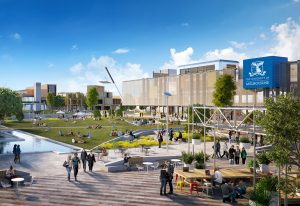A $1 billion price tag has been put on the new seven-hectare engineering campus that the University of Melbourne will build at Fishermans Bend.
Situated 5km from the city’s CBD, the new site is where General Motors Holden was once pumping out new cars for the Australian market, but will now house advanced manufacturing, design, engineering and technology excellence.
“The university will be the catalyst for new collaborations and investments, connecting industry and research in the precinct,” said the university’s vice-chancellor, Professor Glyn Davis. “When surrounded by start-up accelerators, business incubators, cutting-edge research, development and manufacturing facilities and test sites, our students can immediately put ideas into action.”
It’s a point of view backed up by Dr Anne Hellstedt who is the program director, MSE 2015 (infrastructure) for the university.
“The new engineering campus is one key element of the 10-year strategy for the school of engineering,” she said. “We’re committed to developing engineering and IT future leaders and developing new innovations and collaboration with industry. It partners in keeping with our teaching and learning on parcel for our undergraduate students and the majority of our master’s course students.”
While the new campus will be a godsend to students and faculty members alike, there is also a practical reason for the expansion of the campus. The university was running out of room at its Parkville site and with an expected influx of 100 new academics, more space was necessary to meet their research needs.
“At Parkville we have outgrown our space. In terms of recruiting new academics, many of them require new research facilities and experimental research facilities,” said Hellstedt. “Also, research staff are looking to expand their capability and capacity and we are not able to do that on Parkville any longer. So we need that space and have places where we can do stuff like fabricated housing, wind tunnels and have them operating all year around, as well as things like having engine testing space. We will also have high spaces where we can test new drones and the sensor technology that goes with them.”
There is also another reason for the new campus being built and that is it gives enough room for researchers to work collaboratively with industry to produce cutting-edge technologies and products that can then be marketed to the wider world.
“This campus will help us collaborate with industry and develop new prototypes and demonstration-scale products and technologies,” said Hellstedt. “Particularly here in Australia, you have your fundamental discovery research. Then you have industry in that development area of translating research into products and technologies and new innovations etcetera, which is a difficult one. We are looking at bringing academia and industry together to translate that research into innovative new products.”
It’s along that TRL trajectory – technology revenue levels – where academia is at one end and industry is at the other. This will be about both of these aspects working together where they are developing, testing and trialling and coming up with new innovations.
“In terms of the school’s strategy, it is focussed on engagement with industry through our teaching and learning, as well as research and developing more partnerships with industry,” said Hellstedt. “These partnerships are broader and have greater depth over time. There’s a real focus on that academic operation within industry, which I think is a challenge for both industry and academia to get right. We are very committed to that.”
What sort of bang will the university and its faculty get for its buck? Quite a bit. It will have one of the world’s leading aerodynamic laboratories, with Hellstedt saying that these facilities will be unique globally. It will include an air/water interface tunnel that looks at water and wave interactions that feeds into climate change research and modelling.
The prefabrication group will have a research centre into prefabricated housing and have space where they can build and test prefabricated modules.
There will also be a smart grid research laboratory looking to use the facilities themselves to test research where they can manage the energy flows to provide for peaks and smoothing out the national grid.
Also, more space will be given to renewables energies, battery storage and electric vehicles. These are current research capabilities that will all be expanded.
“Giving people more room to do stuff and having a more flexible space that can be refigured more easily over time is key,” said Hellstedt. “The idea that you can have new projects coming into the facility that are plug-and-play is also important. Researchers and students can have more open-plan spaces so they can set up smaller areas within live spaces to do the research. This is all part of our aim to be in the Top 20 engineering and IT universities in the world.”
All this comes about as the engineering faculty gets a number of new appointments at the top end of the faculty. This includes a new Dean of Engineering, Professor Mark Cassidy; Head of School Electrical, Mechanical and Infrastructure Engineering, Professor Joe Klewicki; Head of School Chemical and Biomedical Engineering, Professor Sandra Kentish; and Head of School Computing and Information Systems, Professor Uwe Aickelin.
Overall, the investment of $1 billion includes the purchase, design and construction of the new campus, as well as the upgrade of Parkville’s engineering facilities. It also covers the university’s innovation precinct being built on the former Royal Women’s Hospital site and additional staff to support research, teaching and engagement.
Economic modelling has shown that the University’s 2025 engineering strategy, of which the new campus is an integral part, will provide an $8 billion boost to Victoria’s economy and generate over 15,000 new jobs by 2035.

